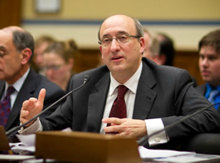Washington Update: Michaels: More regulation is needed

During an at times tense, if not combative, March 16 congressional hearing before a House subcommittee, Michaels said regulations help give clarity to employers about what is required of them under the Occupational Safety and Health Act. Additionally, he said, a number of hazards currently are not regulated but should be.
“You need more regulation. You need clarity,” Michaels told members of the Oversight and Government Reform Committee’s Regulatory Affairs, Stimulus Oversight and Government Spending Subcommittee.
The hearing was one of several convened by committees in the Republican-controlled House since the beginning of the year to explore government regulation and the administration’s plans for additional requirements, and what it may mean for the economy and job creation.
These hearings could be beneficial, but in an era of snappy catchphrases, GOP members and business trade groups tend to portray any proposed regulation as a monster that will destroy jobs, run employers out of business and leave the economy in ruins. (On the other hand, many Democrats and worker advocates can seem overly focused on the benefits of some regulations.) These latest hearings were no different.
Sitting in front of two banners – one questioning the impact that regulations have on construction jobs and the other implying the answer by noting the industry’s staggeringly high 21.8 percent unemployment rate, subcommittee chair Rep. Jim Jordan (R-OH) raised some concerns regarding OSHA regulation.
“The committee has heard from job creators that proposed workplace rules by [OSHA] threaten to impede economic growth in the construction industry,” he said. Although Jordan stressed that safety and business success are not mutually exclusive, just a breath earlier he suggested OSHA’s proposed injury and illness prevention program rule could play a role in halting the construction industry’s recovery.
construction safety
Michaels took offense to this criticism of the proposed rule, telling subcommittee members that the rulemaking still is in the early stages and several details have not been decided. “Some [people] are concerned, but I think some just like to raise red flags,” Michaels said of those worried about the injury and illness prevention program rule. “We’re asking them, ‘Work with us, bring your concerns to us. Don’t announce you’re opposed to it before you even see it.’”
Michaels acknowledged that regulations do have a compliance cost for businesses, but he said OSHA tries to balance that with the need for regulations. Michaels suggested if OSHA did not exist, businesses may be less inclined to take appropriate safety precautions.
“Instead of the photograph in the newspaper of the worker just hanging there being saved [by a safety harness], he’s on the ground dead,” Michaels said. “We see it too often.”
Indeed, subcommittee ranking member Rep. Dennis Kucinich (D-OH) was quick to point out regulations can save both lives and businesses. He noted the 2009 ConAgra Slim Jim natural gas explosion in North Carolina that killed four workers and injured more than 60.
“Before the explosion, 700 people worked at the factory. Today, the factory is shutting down. That’s 700 lost jobs because of a workplace disaster,” Kucinich said.
Natural gas purging, which contributed to the cause of the blast, is not prohibited or regulated by OSHA. Last June, the Chemical Safety Board called on OSHA (.pdf file) to promulgate such a standard in light of the ConAgra blast and the 2010 Kleen Energy natural gas explosion that killed six workers in Connecticut to prevent future occurrences.
Not all regulations are created equal, of course. Some may have the unintended effect of harming the economy or producing an environment not conducive to job creation. But when hazards exist that can result in deaths, job loss and billions of dollars in lost revenue, perhaps it is more prudent to discuss the best ways to craft and implement a standard instead of creating hysteria over the potential requirement.
“Every industry says, ‘It’s going to cost us too much money,’” Michaels said. “Because they don’t try.”
The opinions expressed in “Washington Update” do not necessarily reflect those of the National Safety Council or affiliated local Chapters.
Post a comment to this article
Safety+Health welcomes comments that promote respectful dialogue. Please stay on topic. Comments that contain personal attacks, profanity or abusive language – or those aggressively promoting products or services – will be removed. We reserve the right to determine which comments violate our comment policy. (Anonymous comments are welcome; merely skip the “name” field in the comment box. An email address is required but will not be included with your comment.)

